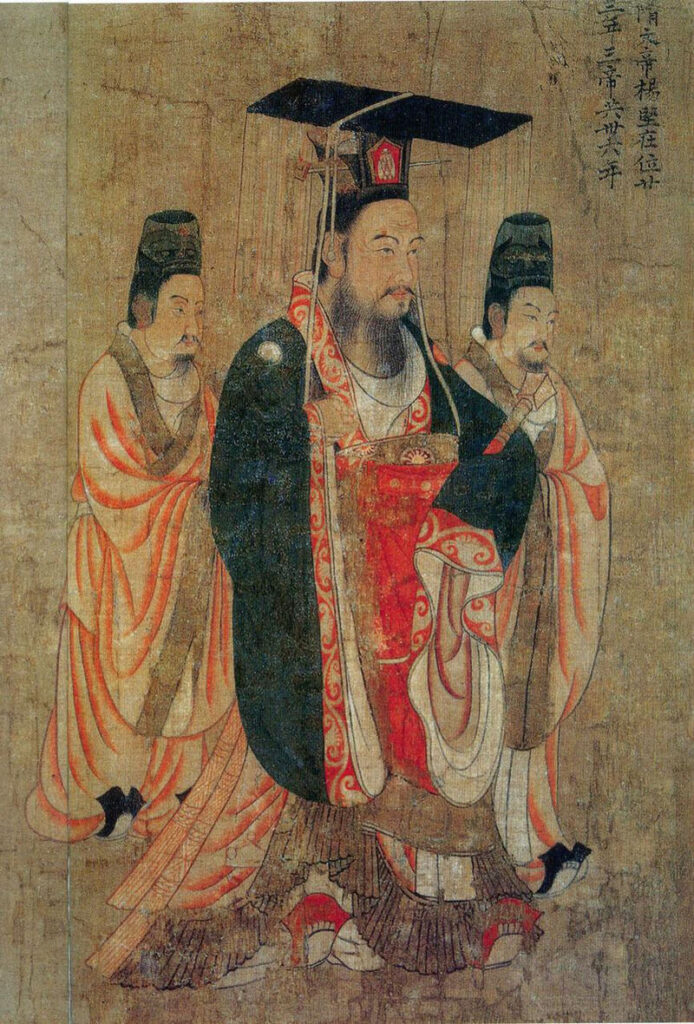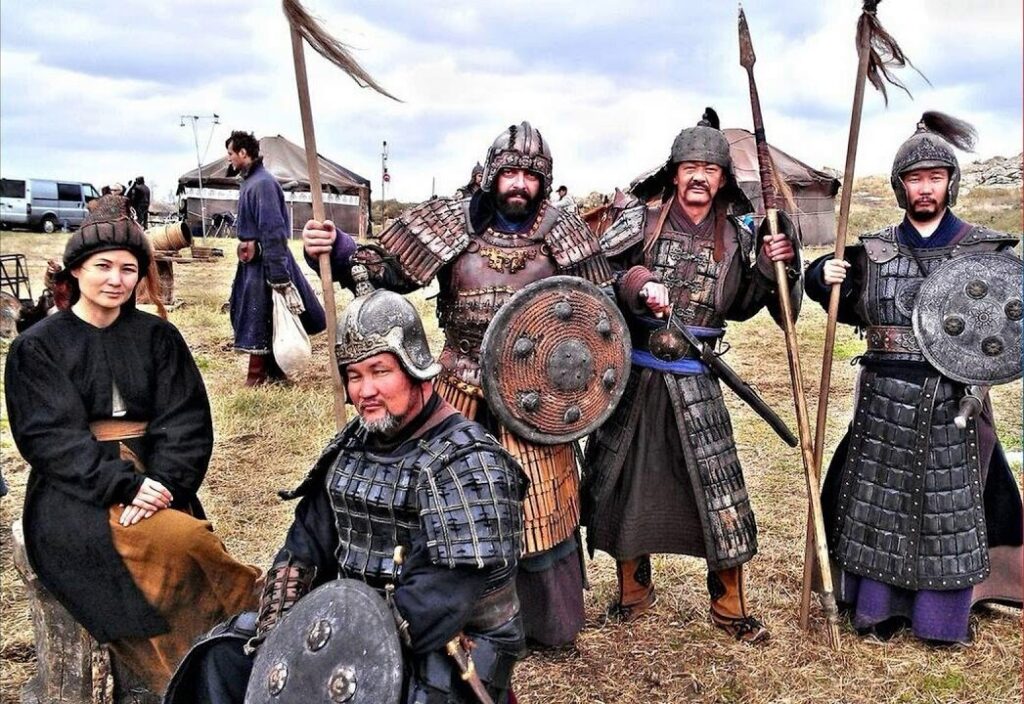In 581, the commander Yang Jiang overthrew the last minor emperor of the Tobak (proto-Mongol) dynasty of Northern Zhou. Yang Jiang founded the new Sui Dynasty, which would soon unite the entire country.

Emperor Wen-di (china.隋文帝), birth name Yang Jian (china. 楊堅; July 21, 541 — August 13, 604) — the Chinese emperor, the founder of the Sui Dynasty (581-618), was the father-in—law of Xuan di, the penultimate emperor from the North Chinese Northern Zhou dynasty. He was the commander of the state of Northern Zhou (557-581).
In the Turkic khaganate, at that time, the khagan Arslan-toba Khan died.
By the time of his death, Turkic El had turned into a centralized state, where the Turks mercilessly collected taxes from all subordinate tribes, while at the same time keeping everyone in check. In the Great Steppe from the Celestial Empire to the Volga, peace came and all kinds of civil strife stopped.
The Turks became the gendarmes of the steppe, maintaining order in it, which led to a certain prosperity. Even with the high tax rate that the nomads were forced to pay for their peace of mind.
After the death of Arslan-Tobo Khan, his son Amrak ruled for some time. But according to the ladder system (power does not pass from father to son, but from older brother to younger brother), he could not claim the throne.
Before his death, Tobo Khan bequeathed the throne to the son of Uncle Amrak Dalobyan. But Dalobian (Turkic. Toremen, the son of Mukan Kagan and his younger wife) was considered low-born and the nobility decided not to put him as a kagan. Under pressure from Shetu (Baga-Oybar Khan), the nobility leaned in favor of Amrak. Dalobian plotted to overthrow the newly-born kagan and take the throne, he and his servants publicly insulted the kagan, remaining unpunished. At the council of the Turkic nobility, it was decided to proclaim the brave Shetu kagan. Dalobian received the title of Apa Khan (the oldest khan) and left for the north. Shetu became Baga Akbar Khan — Wikipedia
Toremen was born from a Chinese woman who herself adhered to a pro-Chinese orientation. At the same time, it was not a treacherous activity. She simply represented the interests of the trade elite, which sought to ensure unhindered trade in cheap silk. And cheap silk could either be begged or taken away. In another way, it was very expensive.
What is bad for this group, the new Chinese emperor Wen-di refused to pay tribute in silk to the Turks. This led to great perturbations.

The new kagan, having ascended, immediately declared war with China
The Chinese deployed a huge infantry army to the border, where they began to repair the Great Wall of China.
But the Turks bypassed the unwieldy Chinese army with horse avalanches and invaded the border territories, leaving not a single village untouched.
Everything would have been fine, but in 582 Kara-Churin Khan (ruler of the western part of the Turkic khaganate) concluded a separate peace with the Chinese. The Eastern Turks did not expect such betrayal, and the Chinese defeated a part of the Turkic army that was operating in the inner provinces of the Celestial Empire. It was only thanks to the personal courage and organizational abilities of Kagan Bagh-Oybar Khan that the Turks were able to regroup and did not allow their complete defeat. They loomed over the border territories of the Chinese, threatening raids.
During the war, a feud arose between Toremen and Kagan and the former fled to Kara-Churin. He decided to overthrow Sheta. Kagan had to make peace with the Chinese in 584.
Almost the entire aristocracy of the Ashina clan opposed Shetu.
Therefore, Shet had to take the humiliating step of kneeling in front of the Chinese ambassador and recognizing himself as a vassal of the house of Sui. In response, the Chinese emperor supported him with free silk, with which he was able to buy the support of part of the aristocracy.
Kara-Churin had to do the same. Sogdian merchants stood behind him, who needed silk for trade, which brought the main income to the western lot of the Turks. He also had to become a vassal of the Sui Empire.
Therefore, the Western and eastern Turks agreed among themselves and the civil strife stopped. Tormen had to flee to Bukhara. There, his soldiers began to rob local farmers, which displeased Kara-Churin, who defeated Toremen and executed him.
Soon, during the hunt, Kagan Shetu also died. His brother Chulokhou became the khagan of the Eastern Turks, who began a war against the Western Turks for influence in the Great Steppe. In 588, he was killed by an arrow, and his troops were defeated. This was the beginning of the watershed between the eastern and western Turks.
After that, Kara-Churin turned his attention to Persia, which did not want to miss the Sogdian caravans with Turkic silk from China.
The Turks launched an offensive against the Persians in the Caucasus and Central Asia. The Persian Shahin shah had to call for the help of a commander from the Parthian family of Miran — Bahram Churin.
Bahram Churin took only veterans to the war with the Turks — from 40 to 50 years old, experienced soldiers who were proficient in archery.
Kara-Churin’s son, Yang-Souh-tegin, acted in the Central Asian direction.
The Persians were able to lure the Turks into the narrow Herat Valley, from which there was only an exit through a mountain gorge. There were 10,000 Turks with war elephants. They were opposed by 12 thousand Persians with flamethrower machines.
The Turks, as always, attacked with a powerful blow from their mounted spearmen. The left flank of the Persians was pressed, but not defeated.
After that, Yang-Souh-tegin sent elephants to attack, which were repelled by fire arrows and machines. The elephants rushed back and trampled the Turks, who fled in a stampede. Bahram Chubin personally shot Yang-Souh-tegin with his bow.
The Turks were defeated! Persia was saved for 50 years, before the arrival of the Arabs.
But the defeat at Herat did not become destructive for the Turkic khaganate. He still had a lot of strength.
Power in the khaganate passed into the hands of the Western Turkic lot, whose ruler Kara-Churin became the informal ruler of the entire Great Steppe.
Moreover, an internecine feud broke out in the Eastern Turkic khaganate between Kagan Yun-Ulug and Prince Zhangar. As a result, Yun-Ulug was killed by assassins in 599.
Kara-Churin defeated the troops of Zhangar, who openly began to support China. Then he began to make devastating trips to Chinese lands. But due to the lack of fodder for the horses, Kara-Churin had to retreat.
In 603, the Germans rebelled in the rear of Kara-Churin, who was at war with the Chinese. Deprived of supply bases, Kara-Churin began to lose soldiers who went to Zhangar. Kara-Churin, who was left almost alone, had to flee to the Xianbians on Lake Kukunor, where he died.
Zhangar, a former agent of Chinese influence, became the khagan of the eastern Turks. In the west of the Turkic possessions, the first independent kagan was Kara-Churin’s grandson, Nili Khan.
Thus, the Turks were finally divided into the Western Turkic and Eastern Turkic khaganates.
